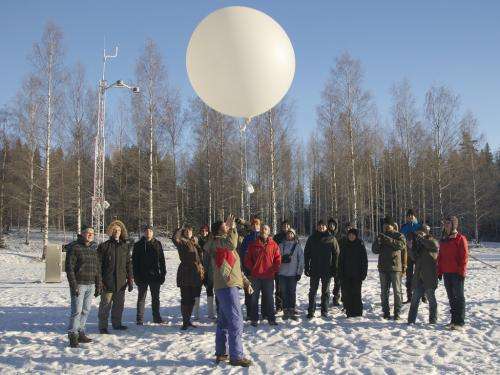Mobile climate station heads to Finland

(Â鶹ÒùÔº) —Last year, the mobile climate-sensing facility called AMF2 spent its days cruising Pacific waters, fixed aboard a working cargo ship traveling back and forth between Hawaii and Los Angeles. Its next stop is a little less warm, but just as scenic: deep in the forested countryside of Finland.
The AMF2 is a piece of an extensive campaign to get more data on the world's climate and atmosphere, called the Atmospheric Radiation Measurement (ARM) Climate Research Facility and run by the U.S. Department of Energy.
Earth's atmosphere is a huge and extremely complex affair that is constantly in flux, responding to changes to the oceans, wind, land, temperatures and many other inputs. More data helps scientists map out how different parts of the system affect one another.
The AMF2 is a mobile set of instruments that specializes in taking data where it's limited or hard to get—thus its trips across the Pacific Ocean last year, an area where we're (understandably) short of data.
The Finland mission focuses on a piece of the puzzle that science is still struggling to understand. The Finnish forest near Hyytiälä, Finland, is part of a type of ecosystem called the boreal forest, mostly made up of coniferous trees like spruce and pine in northern latitudes across the United States, Canada, Scandinavia and Russia. Boreal forests cover more land than almost any other type of ecosystem in the world, and they are thought to play a critical role in cloud formation.
"We are proud to support our next ARM field campaign's mission to collect data on the interaction between forest and climate," said Nicki Hickmon, an Argonne National Laboratory meteorologist who is the site manager for the facility. "Then the science team will analyze the interaction between tiny biological particles released by the forest and their impact on clouds, precipitation and climate."
Trees and forests have many ways of interacting with the atmosphere, Hickmon explained. "Little particles like pollen from the forest—which is mostly birch and Scots pine—become a source of nuclei for clouds to form around," she said. "The idea is to see how gases escaping from the forest affect climate and atmospheric conditions."
Each new location for the mobile facility comes with its own challenges. To make sure the radar isn't obscured by the tall pines of the mature Finnish forest, one calibration reflector will be mounted atop a tower more than 400 feet (127 m) high by staff at the host site, the Station for Measuring Ecosystem-Atmosphere Relations II, run by the University of Helsinki.
The facility began taking data in Finland on Feb. 1 and will remain there for eight months.
Provided by Argonne National Laboratory




















